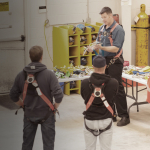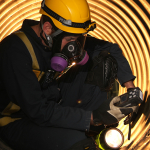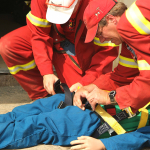
Workers in the healthcare industry are more likely to be injured than any other white collared professionals. ACUTE endeavors to enable workers to return safe and healthy to their families at the end of the day by offering industry-proven training to reduce injuries and causalities. Contact our qualified professionals to get started today to get stellar Hazwoper training to help your team deal with hazards from A-Z including biohazard chemicals. This article looks at the healthcare industry’s hazards and focuses on the challenges specifically of working at heights, in confined spaces, and with hazardous materials. The best way to manage hazards is to have a comprehensive safety program backed by quality hands-on safety training.
Healthcare Hazard Challenges
Stats Can has noted that healthcare workers are more likely to be injured than other white collared professionals with them being 30 percent more likely to be injured. Healthcare workers are exposed to continued stress from shift work, hazardous chemicals, and human factor violence, and repetitive motion. Lego characters in this short film introduce the process of identifying safety hazards.
The Occupational Health and Safety Administration identifies the following challenges for healthcare professionals:
- biological hazards
- chemical and drug exposures
- waste anesthetic gas exposures
- respiratory hazards
- ergonomic hazards from lifting and repetitive tasks
- laser hazards
- workplace violence
- hazards associated with laboratories, radioactive materials, and x-ray hazards.
Along with the hazards listed above, medical professional can also be exposed to chemicals, including:
- formaldehyde, used for preservation of specimens for pathology
- ethylene oxide, glutaraldehyde, and peracetic acid used for sterilization
- numerous other chemicals used in healthcare laboratories
Getting quality training shouldn’t be risky. See what ACUTE customers are saying about our training:
“I’ve been using ACUTE for a number of years now. What started with lift truck and crane training has expanded to have them providing most of my H&S disciplines. The customer service is the best I have encountered; they work with me and accommodate my schedules for multiple locations; our employees really like the trainers and content is the best and most relevant to my needs as I have ever found. I recommend ACUTE to everyone looking for competent, professional training services.”
-Rob
For more reviews, click here.
 Working at Heights Challenges
Working at Heights Challenges
Healthcare professionals in multi-floor complexes may not be aware of the risks and hazards of working at heights. Though there are not very many, providing building safety code is adhered to, here are some height hazards healthcare professionals may be exposed to:
- Exit and rescue hazards – in the event of an emergency, elevators may no longer be functioning, leading to limited means of entry and exit for patients and professionals.
- Elevator malfunctions or maintenance – hospital workers and maintenance staff are exposed to hazards like depleting oxygen and falls when elevator systems malfunction or stall.
- Treatment administered at high altitudes – in some remote high-altitudes regions, physicians may see reduced oxygen levels and temperatures when seeing patients.
- Reduced options for communication – working in an elevated environment may create issues with telecommunication or verbal communication among support staff and teams.
Fundamental Courses to Help Turn Theory into Hands-On Safety Practices
Healthcare professionals need the best Working at Heights training to ensure patients receive the best care and sustainable health outcomes. Here are just a few of the courses ACUTE offers to help medical professionals stay on top of working at heights hazards.

Working At Heights Training Course – Approved by The Chief Prevention Officer of Ontario
In this course, you will learn working at heights legislation, working at heights hazards, fall prevention strategies and systems, fall protection systems, safe work strategies, and how to select and use the proper fall protection equipment.
To view the Ontario Working at Heights standards and requirements, click here.
This course is 8 hours in length (1 day)
Learn more about this course – click here
 Healthcare Hazards within Confined Spaces
Healthcare Hazards within Confined Spaces
Medical professionals may not typically enter into confined spaces, but the management of the hospital or care facility may require employees to enter into confined spaces. Here are hazards associated with the confined spaces that employees need to navigate:
- Cave-ins – hospitals may have tunnels to provide a pathway for pipelines. There is a risk of cave-ins in this type of confined space.
- Wildlife risks – within crawl spaces under certain areas of the hospital, spiders and snakes may be disturbed and cause safety concerns for employees.
- Confined space hazards in industrial machinery or healthcare assets – in a case dated back in the 90’s one employee entered a confined space within an industrial laundry machine and died from injuries.
- Air contamination – within hospital labs or surgery areas, anesthetic chemicals may be used which can impair the normal responsiveness and reasoning of medical professionals, then compounded by confined workspaces.
- Ergonomics – within the supply room or when repairing heavy medical equipment in a confined space, the body’s full range of motions is inhibited and can cause accelerated wear and tear to muscles and ligaments.
This document from LSU Health offers great insights into a comprehensive Confined Space safety program, including an extensive list of confined space hazards based on rooms within the hospital.
Get Maintenance Staff out of a Tight Spot with ACUTE’s Confined Space Training
With the advanced technology and requirements for numerous forms of chemicals, energy, and other substances, there are unique confined space challenges in the healthcare industry. Here is the industry-proven training that can help your hospital or resident care team stay safe. Safety. It’s all that we do.

Confined Space Entry Awareness Training
This training program will familiarize a participant with the requirements of Ontario Regulation 632/05 – Confined Spaces. Furthermore, the training program is intended to provide entrants, attendants, and competent persons the skills and training required to recognize confined space entry risks and to establish measured corresponding controls. Participants will have the opportunity to become familiar with, inspect, and use Confined Space Entry (CSE) access equipment and air quality instrumentation.
This course is 8 hours in length (1 day)
Learn more about this course – click here
 Confined Space Competent Person Training
Confined Space Competent Person Training
This course is for confined space program administrators and those directly responsible for supervising confined space operations, as they require deeper insight and understanding with respect to confined space hazards that may exist or accumulate in a space. These hazards exist or accumulate because of the confined space’s configuration, contents, location, and the work activities to be performed in the space. Those overseeing confined space entry, either directly or indirectly, must be aware of suitable corresponding controls measures to keep confined space workers safe. ACUTE can customize its confined space entry courses to provide equipment-specific relevant training to its clients.
This course is 16 hours in length (2 days)
Learn more about this course – click here
This training program builds on the content of the Confined Space Entry Awareness course to train participants on safety considerations and methodology to safely perform a rescue from a confined space.
This course is 8 hours in length (1 day)
Learn more about this course – click here
 Challenges of Hazardous Materials and Substances in the Healthcare Industry
Challenges of Hazardous Materials and Substances in the Healthcare Industry
- Natural gasses – found in boiler rooms and piping tunnels.
- Radiation – found in diagnostic equipment and irradiator rooms, exposure can cause deterioration of human health without proper protection.
- Electrical energy – professionals and maintenance teams are exposed to this hazardous energy in places like exhaust systems.
- Biological chemicals – crematoriums use biological chemicals and agents. Workers may be exposed to these hazardous chemicals if they are not properly managed.
- Heat – this hazard is often found in areas like industrial washers, crematoria, furnace rooms, and more. Proper management of this hazard is important for both employees and patients.
Source:
https://www.lsuhsc.edu/admin/pfm/ehs/docs/EHS400.02%20-%20Confined%20Space%20Policy.pdf
Get Mastery in Managing Hazardous Materials and Spills with ACUTE Training
Spill Response training will cover the legislative requirements for spill reporting and cleanup. Participants will be taught practical strategies to both prevent and safely contain spills that occur in the workplace. Training programs are routinely customized to reflect client sites and products.
This course is 12 hours in length (less than 2 days)
This training program covers the requirements of the OSHA HAZWOPER standard (29CFR 1910.120). This standard sets out the minimum training requirements for site workers on hazardous waste sites, environmental remediation and emergency projects in the United States of America. The quality and comprehensive nature of this standard makes it applicable and attractive to those employers and workers who work at Canadian workplaces that contain environmental contamination or hazardous materials.
This course is 40 hours in length (4 days)
Learn more about this course – click here
Other great courses to help improve your competency with hazardous materials:
ARC Flash and Electrical Safety
 Workplace Harassment
Workplace Harassment
People pose a significant risk to healthcare professionals who serve clients who may be under the influence of discomfort, pressure, and anxiety, leading to confrontations and injuries to health care workers. Ensure that your team is prepared to handle the most extreme cases of patient interaction, limiting the harm to your team while ensuring safety and high-quality care are delivered. Health and safety publication New Solutions identified workplace harassment and violence as an area of concern for hospital staff.
Hospital staff of all levels should receive workplace violence prevention training, helping to ensure care is delivered at all levels of the organization from staff to patients. The first step is ensuring champions or leaders are in place to drive a comprehensive workplace violence and harassment management program.

Workplace Violence and Harassment
This training program will teach participants the legislative requirements and the importance of a Workplace Violence and Harassment policy. Participants will also be lead through a review of the legislative provisions that prohibit violence and harassment in the workplace, as detailed in the Occupational Health & Safety Act (OHSA). Participants will be given instruction to develop procedures around managing workplace violence.
This course is 4 hours in length (1/2 day)
Learn more about this course – click here
Get Hands-On Training Tailored for the Healthcare Industry Experience
ACUTE’s team understands hospital operations can stretch staff to their mental and physical limits, meaning health and safety training must be thorough and engaging enough that it becomes part of the staff’s regular routine. Empowering your clinical and maintenance staff with compelling training and that helps their day-to-day work is what ACUTE is all about. ACUTE focuses on safety to ensure workers are effectively protected and equipped to navigate all the hazards they may face. ACUTE not only meets government requirements but strives to provide quality, hands-on, and industry-tailored training to each of their clients. ACUTE has a cutting-edge training facility that has hosted several provincial and federal agencies. Here are ways that ACUTE goes beyond government compliance in Ontario health and safety training.
- Open Door Instructor-Student Partnersh
 ip – ACUTE’s training services emphasize client participation. Staff foster relationships with clients and serve as a touchstone for advice moving forward.
ip – ACUTE’s training services emphasize client participation. Staff foster relationships with clients and serve as a touchstone for advice moving forward. - Serving Your Team and Industry – With a vast array of clients in the mining, manufacturing, construction, health, academic, and government sectors, ACUTE brings the best safety practices from across the spectrum to your workplace.
- 100 Years Combined Experience – ACUTE provides comprehensive health and safety training, on-site safety services, and consulting services. With over 100 years of combined experience, our staff offers more than theoretical or abstract ideas. ACUTE offers solutions.
- Track Record of Success – ACUTE is rated 4.9/5 stars on Google reviews, demonstrating a commitment to our clients, quality, and a passion for training.
Contact us today for quality training in your workplace or on-site at ACUTE’s proven training facilities!
ACUTE is located in Waterloo, Ontario, and services customers from cities such as Toronto, Mississauga, Brampton, Hamilton, Milton, Kitchener, London, and Guelph, and other cities from across Ontario.



 Spill Response Training
Spill Response Training
